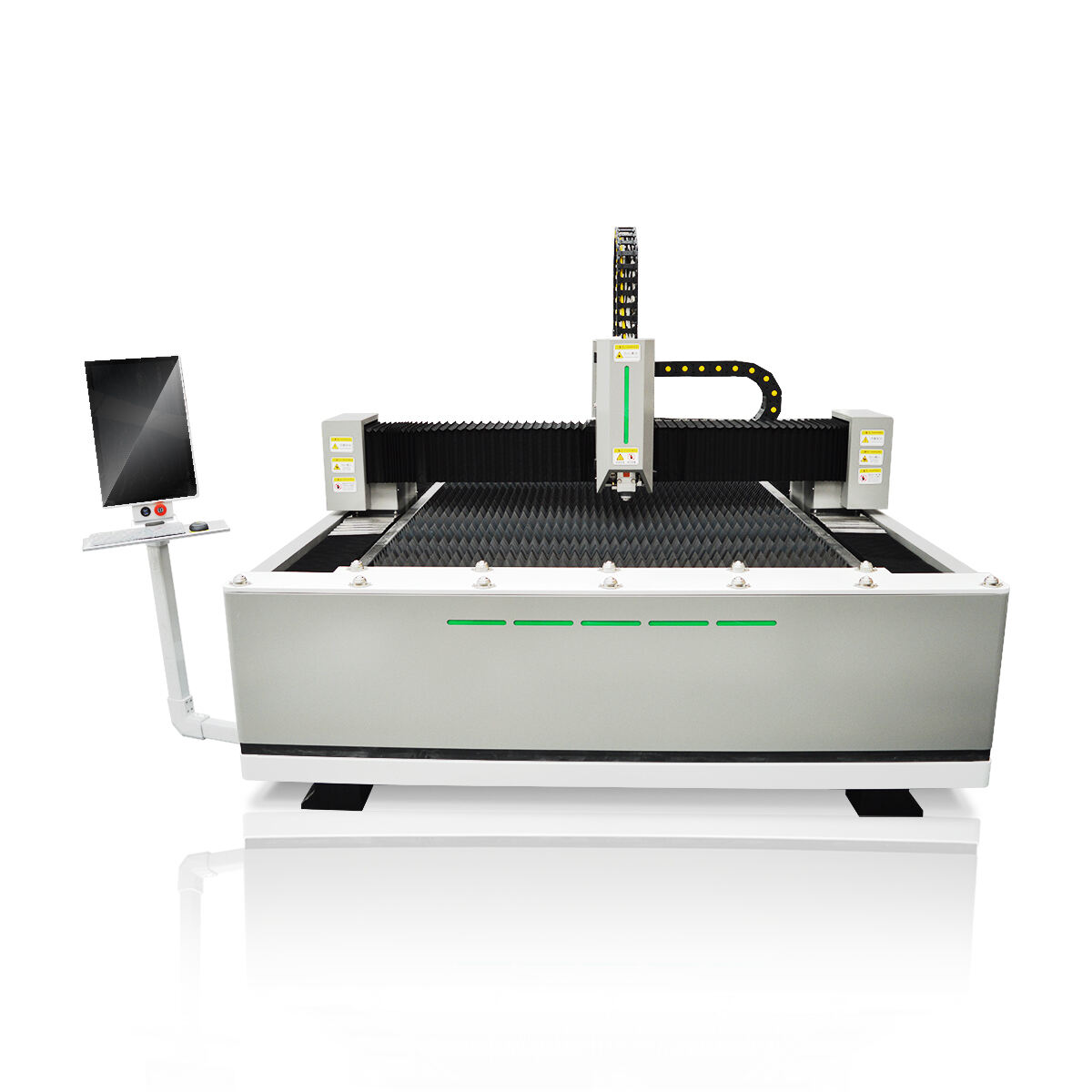Enhancing Precision with Fiber Laser Cutting Machines
Key Advantages of Fiber Laser Cutting Technology
Superior Beam Quality for Microscopic Accuracy
Fiber laser cutting technology stands out due to its superior beam quality, which enables highly detailed cutting with microscopic accuracy. The lasers produce a focused beam with a smaller focus diameter, ideal for intricate cuts and maintaining minimal tolerances. This beam quality allows the processing of diverse materials, including metals and plastics, without compromising on precision. Industry studies highlight that the accuracy of fiber laser cuts can reach up to ±0.1mm. This high level of precision is vital for applications requiring strict specifications, such as in the aerospace and medical industries where minute details can determine the success of the components.
Non-Contact Processing Eliminates Material Stress
One of the primary benefits of fiber laser cutting is its non-contact processing capability, which eliminates mechanical stress applied to the materials. Unlike traditional methods, this approach minimizes the risk of warping or deforming the material, ensuring higher quality edges and reducing the need for extensive post-processing. This not only enhances product quality but also saves time and costs associated with additional finishing. Research indicates that materials cut with fiber lasers exhibit lower thermal stress when compared to conventional cutting methods, preserving the structural integrity of sensitive components like those used in electronics and precision engineering sectors.
Energy Efficiency Reduces Operational Costs
Fiber lasers are celebrated for their remarkable energy efficiency, consuming up to 30% less power compared to traditional CO2 lasers. This efficiency significantly reduces operational costs, marking fiber laser technology as a cost-effective alternative for manufacturers aiming to maximize productivity. Transitioning to fiber laser technology can cut down total energy consumption by as much as 60% over time, providing long-term financial savings. This reduction in power usage not only enhances sustainability in manufacturing practices but also aligns with the global movement towards energy-efficient manufacturing solutions, aiding industries in reducing their carbon footprint while maintaining high production standards.
Technological Innovations Driving Precision
Swiss-Designed Control Systems for Error-Free Operation
Swiss engineering is synonymous with precision, and manufacturers have integrated Swiss-designed control systems into fiber laser technologies to achieve impeccable accuracy. These advanced control systems feature real-time feedback mechanisms, which ensure continued adjustments during operation to maintain precise cutting conditions. Such technologies are pivotal in reducing error margins significantly, ensuring higher quality outcomes for industries reliant on accuracy. Industry experts also point out that these systems enhance precision cutting by utilizing sophisticated algorithms and hardware frameworks, solidifying the reputation of Swiss-engineered solutions in the realm of high-precision laser operations.
High-Precision Grinding Rack Drive Mechanisms
High precision is crucial in modern laser cutting applications, particularly in sectors requiring consistent quality, such as automotive and aerospace industries. The incorporation of high-precision grinding in rack drive mechanisms offers a substantial reduction in backlash, a common issue that compromises cutting quality and repeatability. These mechanisms are reported to enhance not only cutting speeds but also ensure that the desired quality is preserved, according to studies analyzing the efficacy of precision rack drives. The result is a boost in operational efficiency without a trade-off in the quality of the outputs, making these mechanisms a valuable innovation in precision-based manufacturing.
Dual-Temperature Water Cooling Stability
Stable operational temperatures are critical for efficient laser performance, and dual-temperature water cooling systems offer a robust solution. These systems maintain optimal laser temperatures by segregating the cooling processes for different components, which prolongs component life and yields consistently high-quality cuts. Fluctuations in temperature are minimized, significantly enhancing the stability of the laser operations. Experts in the field advocate the adoption of dual-cooling systems as they bring about reliable performance in high-demand setups and are particularly recommended for those pursuing excellence in high-performance laser installations.
Spotlight on High-Performance Fiber Laser Models
WR 1530 Fiber Laser Cutting Machine: Precision Engineering
The WR 1530 Fiber Laser Cutting Machine exemplifies precision engineering tailored for high-performance cutting. This model is renowned for its robust design, allowing it to handle an array of materials with minimal error. Its capability for high-throughput processing makes it especially favored in the manufacturing sector. Many manufacturers choose this machine due to its consistent reliability and advanced features like precision engineering and high-performance cutting capabilities. It's no wonder that sales data reflects a substantial market share for this model, highlighting its popularity and widespread usage.
Enhanced 1530 Model: Advanced Process Control
The enhanced 1530 model takes precision cutting to new heights with its advanced process control features. These upgrades include innovative software algorithms that automatically adjust cutting parameters based on material type and thickness, ensuring optimal performance. By incorporating real-time adjustments, this model significantly improves efficiency and minimizes waste—an advantage that many manufacturers appreciate. These improvements have led to a marked reduction in material wastage and increased yield rates, proving that the enhanced 1530 model is a powerful tool for industries focused on sustainability and efficiency.
Applications Across Industries
Automotive Component Manufacturing
Fiber laser cutting technology plays a crucial role in automotive manufacturing, where precision and intricate design are paramount. These machines excel at producing high-quality components, such as body panels and complex parts, with precise geometry and minimal waste. The ability of fiber lasers to handle materials like high-strength steel makes them invaluable in this industry. Market studies indicate that their application in the automotive sector is expected to grow, primarily due to the increasing demand for precision and efficiency in vehicle production.
Aerospace-Grade Metal Fabrication
In the aerospace industry, the need for precision and reliability is non-negotiable, making fiber lasers the preferred choice for metal fabrication. Aerospace materials are often challenging to cut due to their strength and thickness. However, fiber lasers provide the finesse and control necessary to perform precise cuts without compromising the material's integrity. Reports suggest an increased adoption of these laser solutions in aerospace manufacturing, largely due to the high performance and advanced capabilities of fiber lasers. This trend is driven by the need to produce lightweight and durable components.
Electronics Micro-Cutting Solutions
The electronics industry is highly reliant on micro-cutting capabilities, a domain where fiber laser systems excel. These systems are invaluable for cutting circuit boards and intricate electronic components, necessitating high precision and control. With the ongoing trend of miniaturization in electronic devices, there has been a noticeable surge in the demand for laser micro-cutting solutions. Market analysis has shown that fiber lasers' ability to execute fine cuts with accuracy is increasingly favored over traditional cutting methods, further cementing their place in electronics manufacturing.
Maintaining Optimal Performance and Longevity
Preventive Maintenance for 100,000+ Hour Lifespan
Establishing a preventive maintenance schedule is critical to ensuring that fiber lasers operate efficiently for over 100,000 hours. Regular maintenance activities, such as lens cleaning and alignment checks, are essential to prevent unnecessary downtime and costly repairs. Industry guidelines advise specific maintenance practices that can significantly extend the laser's lifespan and boost performance. To maintain operational efficiency, manufacturers must adhere to these practices diligently.
Real-Time Monitoring of Optical Components
Utilizing real-time monitoring systems for optical components is a proactive strategy to identify and address potential issues swiftly. This approach helps maintain cutting precision and reduces downtime, ensuring continuous machine operation. Experts highlight that real-time monitoring is crucial for the extended lifespan of laser machines, offering significant reductions in maintenance costs over time.
Cutting Parameter Optimization Strategies
Optimizing cutting parameters is crucial for attaining improved cutting quality and efficiency. Strategies involve adjusting speed, power settings, and focal positions to suit the material and thickness being processed, leading to enhanced results. Research indicates that even minor adjustments can substantially improve cut quality and reduce material wastage. Employing these optimization techniques ensures the laser cutting process is tailored to specific needs, maximizing productivity.




